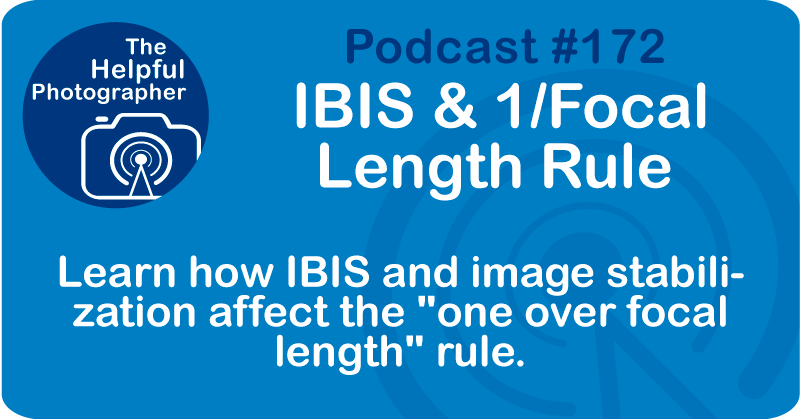IBIS & the 1/Focal Length Rule #172

This episode is for Tony in Australia and Nancy in Fort Worth.
Today, I want to talk about something that comes up all the time in photography circles—especially when you're trying to get sharper images handheld. It's the old rule you've probably heard: the one over focal length rule.
But now that so many of us are using cameras with in-body image stabilization (also known as IBIS) and stabilized lenses, the big question is: does the rule still matter?
What Is the One Over Focal Length Rule?
It's a classic guideline that says when you're shooting handheld, your shutter speed should be at least one over your focal length—assuming that you're shooting on a full-frame sensor, of course. That means if you're shooting a 50mm lens, you should aim for a shutter speed of 1/50 sec. With a 200mm lens, it's 1/200 sec, and so on.
The rule helps reduce blurry images caused by hand shake—especially with longer lenses, where even just a little bit of movement can be very problematic in the final image.
What About IBIS?
Now, here's the twist. With IBIS in the camera body and optical stabilization in many lenses, we're told we can shoot at much slower shutter speeds and still get sharp results. And this is absolutely true. These technologies do help achieve that. Some systems even claim up to five stops of stabilization. Between you and me—I haven’t seen that.
So does IBIS make the rule obsolete? Well... not entirely. Even if IBIS is getting you one, two, or even maybe three stops—in my experience (and I've worked with thousands of photographers over the years)—the biggest variable is still you.
Your posture, how steady are your hands, how are you holding the camera, how well do you brace the camera—all that still matters. For sure, IBIS can give you a stop or two of extra wiggle room, maybe even more. But that doesn't mean you should throw out the rule completely.
In fact, if you follow the one over focal length rule with a stabilized system, you're stacking the odds in your favor—sharp photos almost every single time.
How to Test Your Gear
If you're curious how far you can push it with your own particular camera, do a test. Find a subject with good detail and contrast—something like your garage door or a fence—and shoot handheld using shutter priority. Start with one over focal length, and then gradually slow your shutter speed down in small increments (maybe one third of a stop at a time).
Then check the results in Lightroom or whatever software you use. Zoom in and look for motion blur. This test will tell you how far you can go before your images get soft. It's a great way to figure out what your gear—and your personal capabilities—actually are.
IBIS Doesn’t Freeze Motion
Now, here's something a lot of folks forget: the one over focal length rule is for still subjects. Remember, IBIS only fixes your motion—it does not fix the motion of the thing in front of you.
If your subject is moving, IBIS won't help you freeze the motion. I've seen this a lot. People get super clean results shooting buildings and landscapes at slow shutter speeds, and then they try the same thing for a portrait and wonder why the face is a little bit soft.
Again, that's because IBIS fights your movement, not your subject's. If your subject is swaying or just shifting a bit—like people do naturally—you still need a shutter speed fast enough to freeze them.
And remember, how fast you need to shoot depends on how close you are to the action. A bird flying across the sky, a hundred feet away, might seem slow and easy to capture. But the same bird flying right past your head? That's going to blur unless you're using a much faster shutter speed.
And the other thing is: a longer focal length is going to intensify the movement even more, making the motion appear faster and more exaggerated in your frame. So the closer you are and the longer the lens, the faster you need to shoot to freeze that motion. IBIS will not help.
Final Thoughts
So where am I on this? I think the one over focal length rule is still a really solid foundation—especially for handheld shooting.
Yes, stabilization gives us some extra flexibility. You can often go slower and still get usable shots. But if you stick to the rule—especially when shooting things that are moving just a little bit—and one over focal length is enough to stop the action (like when you're shooting a portrait), you're much more likely to get consistent sharp results.
That's been true in my work, and for a lot of folks I've taught over the years.
So what about you? Do you still follow the one over focal length rule, or do you push the boundaries with your stabilized gear? I'd love to hear what works for you.
So at the end of the day—Tony, stick to the one over focal length rule. I don't care how good you are. And Nancy, go with the one over focal length rule and trust your IBIS. It's working great.
Alright, that's it for today. I hope that was helpful. Until next time, keep on shooting.











